 Harrisville, Michigan - USA
Harrisville, Michigan - USA
www.CrownThistleCollies.com
Our Collies were featured on Animal Planet!
Crown Thistle Collie puppies include U.S. and 100% European Bloodlines
HOME
Collie Breeding, Mother
Care, Whelping Information and
Beautiful Collie Birth Pictures!
The decision to breed your Collie should be made with the backing of as much education and information as you can find coupled with
a strong ethical commitment to
produce only the very best puppies possible. Breeding dogs is not an easy occupation and there is a great deal to consider before you
begin. There is a huge measure of responsibility that you will be accountable for not only involving the dogs you breed, but also to the pups
you produce as well to the prospective
buyers that will invest their trust in you for their future family member.
It would be best to set aside any romantic notions you might have and settle into the fact that this type of work demands a multi-level
commitment that transcends profit-minded motivation.
Excellent puppies are the result of superior parents that have strong
potential to advance the breed.
Among other things, you will have
to decide on an area of concentration you intend to work towards. Do you want to produce pups that will do well in the show ring, have
an aptitude for versatility, display strong
herding instincts, and/or have strong prospects for therapy companions? Will the pups of your prospective breeding excel on
points of health,
conformation, intelligence and
strength of character? Are you truly qualified to assess both the parents and the future pups? You see,
there is much to consider and these
few things mentioned are just the beginning.
I was very fortunate to have been raised around dogs with the influence of knowledgeable family members through whom mentoring
was a part of every day life. Growing up with the insights of several generations of experience to
benefit from gave me confidence as
a breeder myself and provided me with informational resources when needed. Can you gain the support of a mentor,
an experienced Collie breeder who can give you an honest and reliable assessment of the strengths and weaknesses of your
bitch or dog and who can later guide you through all of
the aspects of genetic research, breeding, whelping, puppy care and public affairs? A sincere and dependable breeder willing to be your mentor will be a most valuable source of support, one that
will make you a better breeder for having invested the time to learn. I'm certainly glad it was available to me!
Finally, do you have the
endurance and strong sense of commitment that it takes to be responsible for the care and well being of your pregnant bitch as well as
the firm intention to be certain that your pups are placed in suitable homes? The future stability of each and every puppy is a profound responsibility
that you must pledge yourself to 100% before you bring them into the world. Breeding and selling puppies is not a money-making venture. You will find out very
quickly that the monetary compensation from the sale of your pups will fall drastically short of the value of
the endless hours of work you will have invested into each litter, not to mention the health care and Veternary expenses.
Dog breeders are a special group of people that dedicate themselves not only to the future of the breed they work with but to
the trust of
the public who invest faith and hard earned money into the promise of a sound and worthy family companion.
You will want to strive to align yourself with the very highest standards
of those breeders who set the finest example of what it means to breed dogs with honesty and integrity.
The following is a pictorial essay addressing the fundamentals of dog breeding and canine birth. It should be helpful to those who have little or no experience related
to the basics of canine breeding. It is not intended to take the place of the advice of a licensed Veterinarian neither is it presented
as a final authority. It is submitted as
a foundation source of information that you can build on through further research.
First, your bitch should have a thorough exam by a licensed Veterinarian following his or her advice thereafter on all matters
related to breeding your bitch. After establishing that you have a sound bitch to breed, you will be concerned with the timing and
general behaviour of a successful mating.
Now you will be looking for the beginning of her cycle or "heat"
which will take place for the first time between ages 6 to 12 months
and then
on an average of every 6 months thereafter - allowing for the fact that some females cycle more or less often than this.
The canine cycle is divided into 4 stages:
Anestrusis the rest time between heats.
Proestrus which refers to the first days of heat during which will be seen swelling of the vulva and beginning bleeding.
Follicles containing
the eggs mature over a period of nine days. Fertilization can not happen at this stage.
Ovulation testing can be done at the end of this period.
Esterus or "standing heat". This is the time when the female will willingly accept the male.
Her bleeding will have lessened and the blood will turn to a lighter shade of red or sometimes even seem to stop.
Her behavior will change dramatically from an attitude of aloofness around a male to that of acceptance and encouragement
for his attention.
She will lift her tail at his approach and stand steady, even lifting her backside, during his attempt to mount her.
The reactivity of her being pet or tapped near the base of her tail which results in the bitch moving her tail off to one side is called
"flagging". To test for flagging, gently but firmly rub your hand down her back to the base of her tail and note her reaction.
The average bitch ovulates on day 11 of her heat cycle. Her acceptance of a male can occur anytime around or after day 7
(starting from the 1st day of bleeding).
Metestrus is the stage that readies the uterus for pregnancy. If fertilization does occur the
fertilized eggs take up to a week before they attach themselves to the uterine wall.
If fertilization does not occurs this stage reverts back to anestrus.
Breeding or exposure to the male is often recommended on days 10 - 12 & 14.
It is important to note that dogs have a
unique method of breeding, they "tie", or become hooked together. Becoming "tied" is the result of a successful copulation and they will stay tied for up to 20 minutes.
It is by this means that fertilization becomes optimal as sperm is being ejaculated by the male in pulses during the entire time they are tied together.
During this period of being tied the male dog may remain on top of the bitch, or slip off to one side with all 4 feet on the ground
or even rotate and reposition himself
around
until both are facing in opposite directions with their genitals still engaged. It is very important that the female be restrained if necessary
as on rare occasion they become overly anxious and determined to terminate the interlude by running away. Her unrestrained actions
at this point can cause injury to either canine, especially the male as he is otherwise helpless to change his situation. It can also
occur that the male will require restraint from desiring to run about.
Remember, a female begins her cycle
by bleeding. This bleeding will begin very lightly and should be carefully noted on the day it starts. You can use a tissue and gently wipe
the vulva of your bitch to check for the start of her heat cycle. You bitch will whelp approximately 61 days after conception
Now, lets take a look at the behaviour patterns of Lassie and King during a mating on day 14 of Lassies heat cycle.
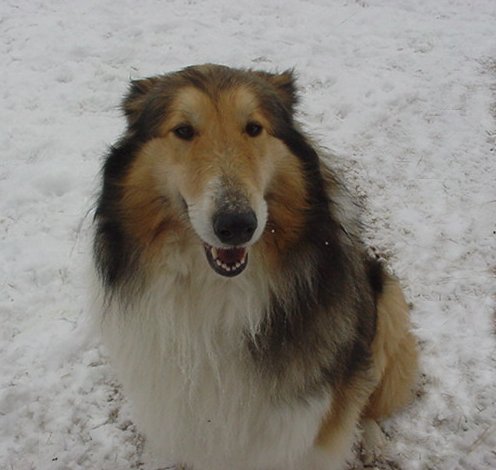
Crown Thistle's Lassie in good emotional and physical health, about to be introduced to a male.
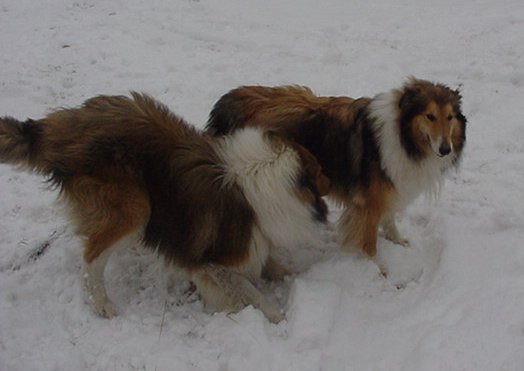
Crown Thistles King Arthur bounds with playful enthusiasm up to Lassie.
His puppy like antics leave Lassie
wondering!
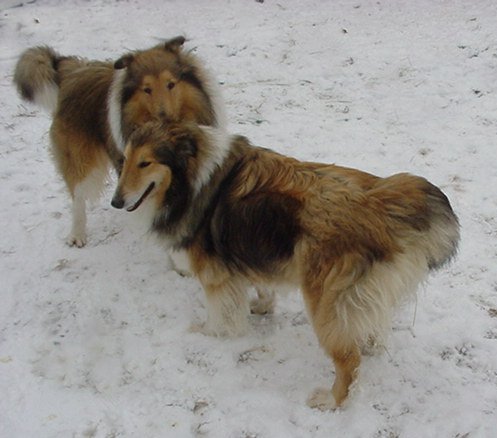
King settles down a bit and Lassie responds by flagging or moving her tail to one side thus
displaying her willingness to be bred.
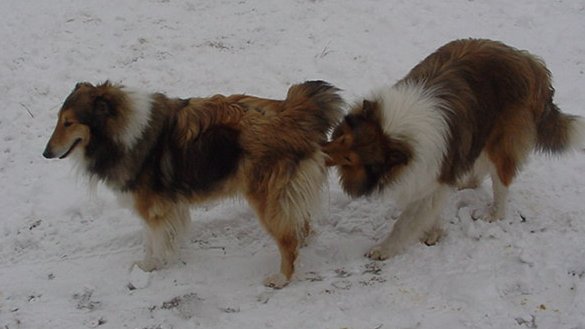
King becomes more attentive and Lassie continues to demonstrate her readiness to be bred.
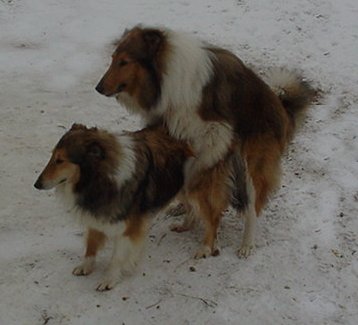
King mounts Lassie, she remains steady and lifts her backside.
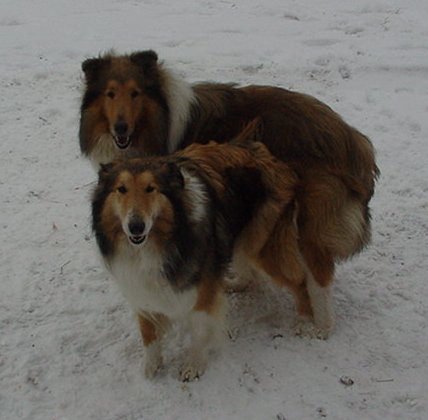
King is tied with Lassie and thus a successful breeding has occurred and will need to be documented.
Canine Mother Care
Excellent mother-care of your Collie bitch should begin long before breeding as a continual cycle of superior care. Quality nutrition, exercise, health checks and grooming are part of the ongoing process that keeps your female healthy and happy.
Meticulous attention to the well being of your bitch will keep you tuned in to her emotional health as well. You need to really know your dog and be very observant, especially during pregnancy. Her emotional health is as important a consideration during pregnancy as her general physical health.
Once she is bred, the time will pass very quickly. Every single day counts so pay good attention to her personal needs of grooming, diet and health care. A healthy mom will be much more likely to have healthy puppies. A healthy mom will also be much more likely to be a good mother. Give your expectant mom all of the attention she needs and then spoil her with extra!
A few weeks before her due date, be sure to bathe your special girl and groom the hair away from her nipples. Don't wait more than half way into her pregnancy to do this because it will only make her more uncomfortable the farther along she is. Groom her before her pregnancy becomes cumbersome.
In the days just before labor, your female will have to urinate more frequently. She will be experiencing increased pressure on her bladder, the closer she gets to labor, as her puppies grow inside her. Don't ever make her wait to go outside. Give her every opportunity to relieve herself - try to think of it even before she does. She will also likely have a mucous discharge from her vagina as well. That is normal.
You will be able to express milk from her nipples in the days just before she births - This is a sign that the birth of her puppies is very near.
 Milk Expressed from Nipples
Milk Expressed from Nipples
You'll probably notice her wanting more of your attention. She needs reassurance. Some dogs need extra attention more than others. If you have a first time mom, she will probably demonstrate a desire for your attention even more. Don't overlook this. Pet her, reassure her. We cuddle our moms and pet them and give them lots of praise.
Never overwhelm your dog, give her what she needs but don't impose on her "space" if she wants to be left alone.
Anxiety is very bad for a mom during late pregnancy. So, we discourage well meaning attention from visitors who our dogs do not know. New sounds, smells and unfamiliar people can cause the female to feel insecure in the last few days of pregnancy.
Concerning meals, you may have to feed her smaller amounts more frequently to be sure she is eating
enough in a day. Pay attention to this, excellent nutrition is vital to her and her unborn puppies so
don't overlook it. Her stomach is being quite crowded by her growing babies and she will not be inclined to
eat large amounts at a time.
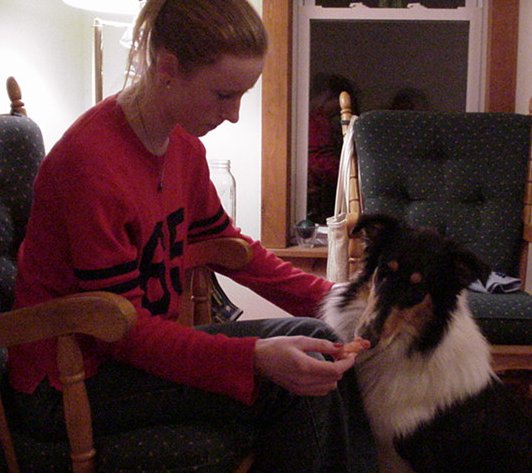 Offer Frequent Nourishing Snacks Especially During Late Pregnancy
Offer Frequent Nourishing Snacks Especially During Late Pregnancy
Make her meals smaller and really yummy (we combine both wet and dry dog food together and make a nice warm gravy with an egg, milk and water - they can't resist it!!). We always say, "do whatever it takes". We even cook a whole turkey or a leg of lamb when necessary to entice our moms to eat really well, especially if it looks like one is not gaining enough weight. We feel that there is no such thing as going over board. Excellent nutrition is the foundation for excellent health, especially during pregnancy, healthy puppies and a long healthy life! Keep clean water available at all times.
We feel that milk and eggs are excellent nutritional supplements.
We raise dairy goats, sheep and chickens and supplement the diet of all of our dogs with fresh goat milk,
cooked lamb and eggs. If you are concerned that milk will make your dog scour (have diarrhea),
add only a little to their diet at first and slowly increase it to a cup or two a day. Cow milk seems
to cause much more digestive irritation to dogs (and humans!) than goat milk does. Goat milk is simply
easier to digest. We prefer to supplement only with whole, unpasteurized goat milk. All of our puppies
are weaned with goat milk as a small supplement to their diets and we have great success with it.
It gives our dogs beautiful, soft, shinny, healthy coats too!
Labor
Birth Supplies
You will need:
Several clean towels
Scissors (sharp/blunt preferred)
Alcohol, Hydrogen peroxide (for blood stain clean-up)
Warm birthing area
Heating pad (for later use with newborn puppies as needed)
Powdered infant canine formula and animal baby bottle (just in case)
Calm attitude.
When labor begins you will note restlessness in your female. She will probably have spent the days immediately before the onset of labor much less inclined to leave her area as she begins to make a "nest" for her comming babies, and more shy about the approach of strangers. As her contractions become regular and more intense, she will dig a lot in her area to create a "cradle" for her babies. She will turn herself around a great deal too trying to find a comfortable spot.
Most of our moms find that "spot" only in our immediate company and refuse to settle anywhere else!
So armed with lots of fresh clean towels, we take shifts with a laboring mom.
Such moments are so tender and fascinating! But, no matter where your female whelps, be sure not to crowd her. Some females really, really guard their privacy and might not want your attention no matter how well intended or gently it is offered. Every one is different and to each her own!
As birth begins, your female will begin to push. As the puppy descends and comes through the birth canal the pups body begins to emerge. Your bitch will pay constant attention to her vaginal area during this time.
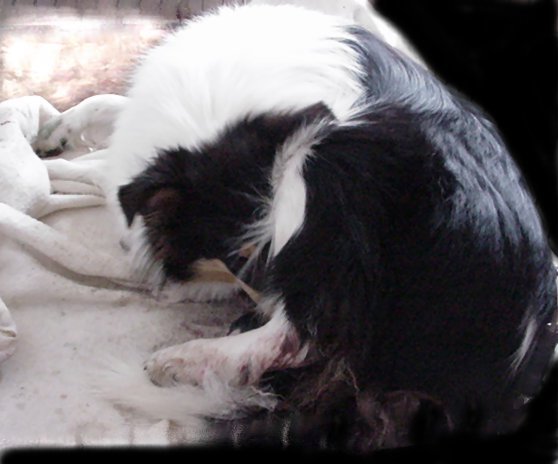
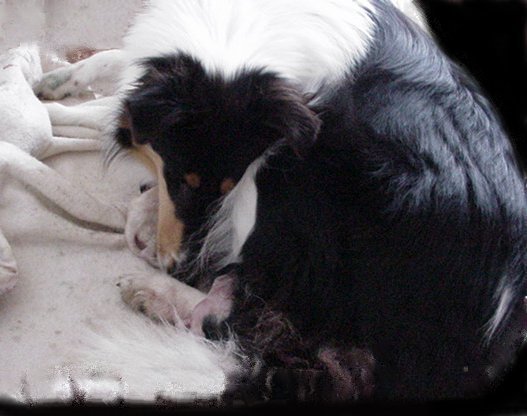
You may notice this as a darkish bubble beginning to protrude from her vagina. This is the puppy enclosed in the amniotic sac. Leave this alone. DON'T attempt to rupture the sack at this point!
There is no need to interfere or rush things. She may push just to this point and then take a few seconds rest. She might even stand up again and dig a little before lying back down. This is normal, don't interfere. Birthing slowly is the most healthy way for the baby to come out. The mothers tender vaginal tissues won't tear and the baby's arrival won't be traumatic. Slow and steady is just the way birth was meant to be!
We do not allow strangers or well-meaning friends to attend puppy births. Despite the fact that birth is the most natural of body functions in all species (including humans!), most people are generally not familiar enough with it or adequately educated about birth to make their attendance safe and meaningful. Too often people fear birth and grossly misinterpret it as a crisis needing rescue management. Then they tend to project that anxiety onto the birth environment and even panic. Panic leads to unwarranted manhandling and interventions, and those interventions can lead to the death of the puppy (puppies) and even the mom. Dogs are so very, very sensitive to emotional sensations. They accurately read even well hidden human intentions. Anything other than the familiar energies of family members (and sincere loving and un meddlesome encouragement) just does not belong in the canine birth environment. If you want to share the birth of your puppies, take a video of it and pass it around. That keeps inexperienced viewers at a safe vantage point!
The mom will usually push slowly and carefully so the baby does not explode out like a cannon ball. Remember,
she knows what to do. Just feel glad that she is sharing this intimate event with you. Don't get excited or interfere with the process. Stay calm and QUIET - talk as little as possible. The less you excite her, the more accurate her instincts will be and the better job she will do doing what comes naturally!
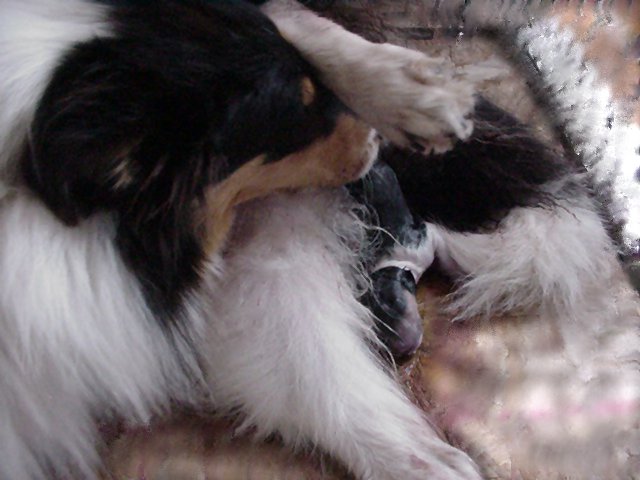
A Puppy is Being Born!
Willow Pushes the rest of the puppy out. He is partly in the amniotic sack.
At about this point, (when most if not all of the baby is out) it would be appropriate to rupture the membranes (carefully pinch it with your fingernail) and clear them away from the baby and wipe the newborns face off a bit. We recommend this action and do it ourselves at all births, though occassionally it ruptures on its own as the pup is being born. We don't like to wait if the puppy is born in the sack, we remove it right away and suggest you do too.
The timing and necessity of assistance is really determined by individual
circumstances and best interpreted by experienced attendants. There are so many variables.
The rule of thumb is that most experienced canine mothers would have birthed their puppies without any help or attention from anyone.
Certainly dogs in the wild do - but there is generally no way to assess the viable outcomes (live puppies) from those (wild dog) births
so in my opinion (Casey's), the natural abilities and outcomes of the births of wild dogs is not a fair argument or reasonable
comparison for the management of domestic dog births. The fact is, domestic dogs occasionally require skilled assistance;
it is sometimes necessary and
very important - even vital to a positive, optimal outcome. If you are going to breed dogs, you should commit yourself to the
constant study of canine birth and be willing at all times, day or night, to attend the births. Talk to
Vets and
experienced dog breeders and learn all that you can. You will find dog breeders very willing to share information and their love of
dogs!
Become a lifelong learner and never be afraid to ask questions - that is an absolute rule of responsible management.
The examples of when your assistance could become necessary are many. Such as in the case of a new mom who might
greatly benefit from well timed help and comfort when she finds labor and birth confusing. This happens sometimes.
If at all possible and only when needed, you want to offer gentle encouragement. Usually your support is sufficient simply by quietly being present.
Or your help could be required in the case of a mom (experienced or not) birthing a large litter,
who might become overwhelmed by the sheer numbers of her puppies during birth - gentle assistance
in such a case becomes very, very warranted.
Another example would be fast births. Normally, puppies are born at intervals of an hour or so.
This is natures way of allowing sufficient time for the mom to clean the newborn, get him started and warm him up
(with lots and lots of licking and nudging), as well as clean up herself and her birth area and ready all for the arrival
of the next pup. But occasionally puppies come too quickly for the mom to keep up with and track of.
It is part of the unfortunate complication imposed on dogs by humans who have, for decades, been breeding them for production
and large litter numbers (to equal higher profits). Too often dogs are turned into commercial producers, literal birth machines.
Unfortunately, large litters can be a complication unto themselves.
Remember, there is a big difference between responsible, well timed assistance and "fear management".
No matter what happens during a birth, make your assisted maneuvers well thought out and steady.
Don't rush and don't let anyone else get their knickers in a twist in an attempt to be a saviour. Don't become frantic and
clumsy either (unleashed emotions and excitement causes clumsiness). Stay quiet, calm and measured in all your ministrations.
Allow yourself to be open to what is going on at all times so you can work in harmony with the moment. Birth is normal - that
fact is the ultimate truth.
Now, I am not saying that birth isn't an emotional time, it really truly is - you even might find yourself brushing aside a tear.
And I am certainly not saying that puppy deaths do not occur; unfortunately, sometimes they do and it hurts.
Sadly, birthing mothers even die (though very, very, very rarely), and that is a terrible tragedy.
It's just important that those who might be considering breeding dogs, or any other animal,
be willing to apply themselves to all of the aspects involved with a reasonable and dedicated heart and mind. Be balanced.
Once the membranes are pulled away from the newborn, the mom will begin cleaning her baby herself.
Within a moment or two the placenta will be birthed. We prefer to clamp and cut the umbilical cord
(about 1 inch from the baby) instead of allowing the mom to tear it away. It helps prevent umbilical hernias.
The mom will eat the whole placenta very quickly. This is a very good supplement for her so we allow her to.
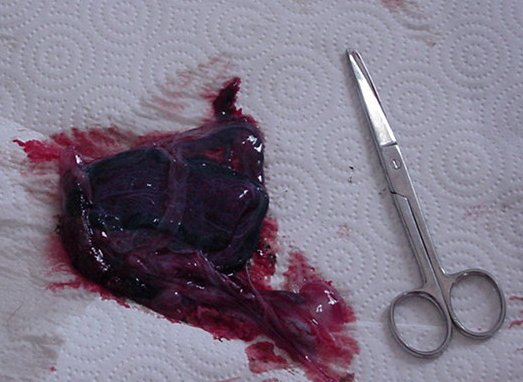 A Healthy Placenta
A Healthy Placenta
Once the pups are all born, make sure you let mom go outside to relieve herself. She probably will not feel the urge to urinate immediately after birthing even if her bladder is full . She also will need gentle encouragement to leave her pups, you may actually have to insist and urge her outdoors and stay with her while she does her duty - and she will! Just make very sure labor is really over and monitor her outside at all times. Once she returns to her litter, give her lots of praise and have a nice bowl of nourishing food specially prepared and waiting for her. Remember, give her plenty of fresh water too, she is going to get thirsty making milk for her puppies!
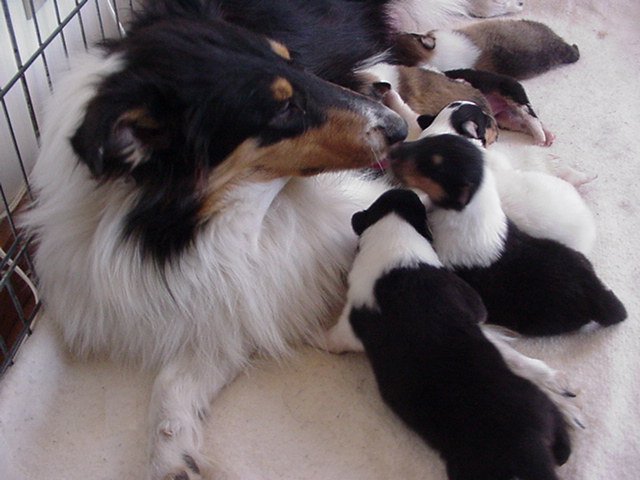 Willow & her 1 1/2 week old pups
Willow & her 1 1/2 week old pups
We hope you have enjoyed this Collie birth information. Please pass this page on to home schooling groups and any other student groups who might be interested. Just copy this link
http://crownthistlecollies.com/ctwhelp.html
We would like to remind viewers that our work is copy written and photos should not be down loaded without permission.

| | | | | |